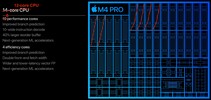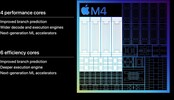MediaTek Dimensity 9300 vs Apple M4 Pro (12 cores) vs Apple M4 (9 cores)
MediaTek Dimensity 9300
► remove from comparison
The MediaTek Dimensity 9300 (MT6989) is a high-end SoC for smartphones and tablets based on Android. For the first time, the CPU no longer uses classic energy-saving cores, but only so-called big cores. In this case, four Cortex-X4 cores with up to 3.25 GHz each and four additional Cortex-A720 cores with up to 2.0 GHz each. The manufacturer has also increased the level 3 and SLC cache by 29% compared to its predecessor, which now has a capacity of 18 MB.
In initial benchmarks with a Vivo X100 Pro, the performance is roughly comparable to an Apple A15 or a Qualcomm Snapdragon 8 Gen 2.
The integrated MediaTek APU 790 fully relies on generative AI and aims to accelerate adapted algorithms by a factor of eight. Energy efficiency is said to have been improved by 45 percent. With the MiraVision 990, displays can be operated in Ultra HD at up to 120 Hz and Google Ultra HDR image display (from Android 14) is also supported.
The graphics unit is an ARM Immortalis-G720 MP12 is used.
The SoC is manufactured using the 3rd generation 4-nanometer process at TSMC (N4X).
Apple M4 Pro (12 cores)
► remove from comparison
The Apple M4 Pro 12-Core CPU is a high-end SoC for laptops and mini PCs that was introduced in September 2024. It has 8 of the 10 powerful CPU cores running at up to 4.5 GHz and 4 efficient cores running at up to 2.6 GHz. The integrated 16-core GPU and at least 24 GB of fast LPDDR5x memory at 273 GB/s (depending on configuration) are included, as well as USB 4 and Thunderbolt 5 support.
The integrated neural engine with 16 cores (up to 38 TOPS) can be found in the entire M4 chip family. In addition, all M4 processors are assumed to be based on the ARM v9.4-A architecture to some degree.
The CPU performance when using all cores is similar to a AMD Ryzen AI 9 HX 370 (Cinebench R23 slightly faster on average). The modern Core Ultra 9 288V can be clearly outperformed. In terms of single-core performance, the M4 Pro scores very well and is on a par with the fastest Intel chips, such as the Core i9-14900HX. Interestingly enough, the M4 and the faster M4 Pro variant with 14 cores were 4-5% faster than the slimmed-down entry-level M4 Pro in Cinebench (Geekbench at the same level).
The power consumption during Cinebench 2024 Multi is around 40 Watt at the beginning (according to powermetrics) and then goes down to around 32 Watt (sustained). Combined with the GPU (Cinebench + Valley) the SoC can hit 47,5 Watt peak at the beginning, but then reduces its power draw to 31 Watt combined (22 W CPU + 9 W GPU).
The 3 nm TSMC process of the 2nd generation, with which the M4 Pro is manufactured, offers good energy efficiency.
Apple M4 (9 cores)
► remove from comparison
The 9-core Apple M4 is a rather fast ARM architecture processor (SoC) that sports 9 CPU cores, a 16-core neural engine and a 10-core GPU with hardware RT support and other modern features. Wi-Fi 6E and Bluetooth 5.3 as well as Thunderbolt 3 and USB 4 are all onboard, too. The M4 debuted in May 2024 as part of an iPad launch event; it has 3 performance cores running at a clock speed of up to 4.3 GHz and 6 efficient cores running at way under 3 GHz whereas the M3 (10 GPU cores) has 4 performance cores and 4 efficiency cores.
The faster 10-core M4 chip delivers 10% higher multi-thread performance and 15% higher graphics performance, to give you a rough figure. More importantly, the 10-core M4 can be had in systems with an active cooling solution, such as Fall 2024 MacBook Pros, whereas the 9-core one is an iPad Pro exclusive. Systems with a fan deliver much higher sustained performance than the ones without it.
Architecture and Features
The new CPU cores run at faster clock speeds than what the M3 was capable of and they also feature minor architectural improvements. The CPU cores are thought to be based on the ARM v9.4-A microarchitecture to a certain degree. The M4 comes with 16 GB or more (depending on the SKU) of on-package LPDDR5x-7500 RAM whereas the M3 was limited to 6400 MT/s. The updated NPU delivers up to 38 TOPS of performance for AI workloads.
Performance
Single-thread performance, multi-thread performance and NPU performance all got a noticeable boost compared to what we had with the M3 (10 GPU cores). The new processor is about 11% faster than the M3 in short-term multi-thread workloads while besting every M3 series chip possible in single-thread tasks by a comfortable margin. Geekbench 6.2 Multi puts the 9-core M4 right above the Core i9-13900H and the Ryzen 7 7840HS; in fact, the M4 is just 3% slower than Intel's top-of-the-line Core Ultra 9 185H chip. A 13% to 18% single-thread performance improvement over M3 series chips is evident if we look at Mozilla's Kraken test results. Octane V2 seems to think the M4 is just 4% slower than Intel's mighty Core i9-14900HX. CrossMark results suggest the M4 is about as fast as the Core i9-13900H.
The 10-core M4 is about 10% faster in multi-threaded tasks than the 9-core part is. It also delivers just slightly higher single-thread performance.
While Apple undoubtedly deserves some praise for what it managed to do here, it is important to highlight that all of the tests we did involve short-term workloads only. The M4 will suffer from heavy throttling if subjected to long-term workloads as there is no active cooling inside that super-thin iPad Pro case.
Graphics
The M4 GPU (10 cores) has hardware support for ray tracing as well as mesh shading and other modern technologies. It supports external displays with resolutions as high as "8K".
As far as performance is concerned, it appears the 9-core M4's GPU runs at significantly lower clock speeds than the (otherwise the same) GPU built into the 10-core M4 chip. This leads to a disappointing situation where what's supposedly a newer graphics adapter is about 10% slower than the 10-core GPU built into the M3. Still, this M4 GPU delivers very decent benchmark scores that put it in the same ballpark as the Radeon RX 6500M.
Power consumption
The chip's sustained power consumption is limited to ~7 W, with short-term peaks of up to 14 W possible.
The chip is built with a "second generation" 3 nm TSMC process that's still cutting-edge as of late 2024.
| Model | MediaTek Dimensity 9300 | Apple M4 Pro (12 cores) | Apple M4 (9 cores) | ||||||||||||||||||||||||||||||||||||||||||||||||||||||||||||||||
| Codename | Cortex-X4 / A720 | ||||||||||||||||||||||||||||||||||||||||||||||||||||||||||||||||||
| Series | Mediatek Dimensity 9000 | Apple M4 | Apple M4 | ||||||||||||||||||||||||||||||||||||||||||||||||||||||||||||||||
| Series: M4 |
|
|
| ||||||||||||||||||||||||||||||||||||||||||||||||||||||||||||||||
| Clock | 2000 - 3250 MHz | 2592 - 4512 MHz | 2900 - 4400 MHz | ||||||||||||||||||||||||||||||||||||||||||||||||||||||||||||||||
| L3 Cache | 18 MB | ||||||||||||||||||||||||||||||||||||||||||||||||||||||||||||||||||
| Cores / Threads | 8 / 8 4 x 3.3 GHz ARM Cortex-X4 4 x 2.0 GHz ARM Cortex-A720 | 12 / 12 8 x 4.5 GHz Apple M4 P-Core 4 x 2.6 GHz Apple M4 E-Core | 9 / 9 3 x 4.4 GHz Apple M4 P-Core 6 x 2.9 GHz Apple M4 E-Core | ||||||||||||||||||||||||||||||||||||||||||||||||||||||||||||||||
| Technology | 4 nm | 3 nm | 3 nm | ||||||||||||||||||||||||||||||||||||||||||||||||||||||||||||||||
| Features | ARM Immortalis-G720 MP12, Wi-Fi 7 up to 6.5 GBit/s, Bluetooth 5.4, LPDDR5T-9600 @ 4800 MHz, Imagiq 990, AI 5G Modem up to 7 GBit/s, | Unified Memory LPDDR5X-8533 (273 GB/s), 16-Core Neural Engine, Media Engine (Encoding / Decoding: H.264, HEVC, ProRes, ProRes RAW, AV1 Decoding only) | Unified Memory LPDDR5X-7500 (120 GB/s), 16-Core Neural Engine, Media Engine (Encoding / Decoding: H.264, HEVC, ProRes, ProRes RAW, AV1 Decoding only) | ||||||||||||||||||||||||||||||||||||||||||||||||||||||||||||||||
| Architecture | ARM | ARM | ARM | ||||||||||||||||||||||||||||||||||||||||||||||||||||||||||||||||
| Announced | |||||||||||||||||||||||||||||||||||||||||||||||||||||||||||||||||||
| Manufacturer | www.mediatek.com | www.apple.com | |||||||||||||||||||||||||||||||||||||||||||||||||||||||||||||||||
| L2 Cache | 4 MB | 4 MB | |||||||||||||||||||||||||||||||||||||||||||||||||||||||||||||||||
| TDP | 32 Watt | 9 Watt | |||||||||||||||||||||||||||||||||||||||||||||||||||||||||||||||||
| TDP Turbo PL2 | 40 Watt | 14 Watt | |||||||||||||||||||||||||||||||||||||||||||||||||||||||||||||||||
| iGPU | Apple M4 Pro 16-Core GPU | Apple M4 10-core GPU |
Benchmarks
Average Benchmarks MediaTek Dimensity 9300 → 100% n=6
Average Benchmarks Apple M4 Pro (12 cores) → 222% n=6
Average Benchmarks Apple M4 (9 cores) → 178% n=6
* Smaller numbers mean a higher performance
1 This benchmark is not used for the average calculation












